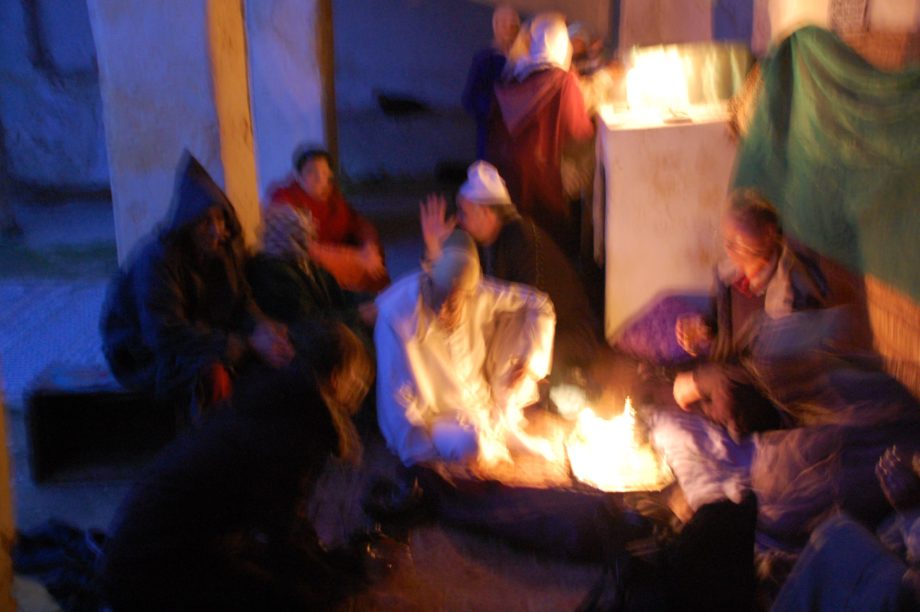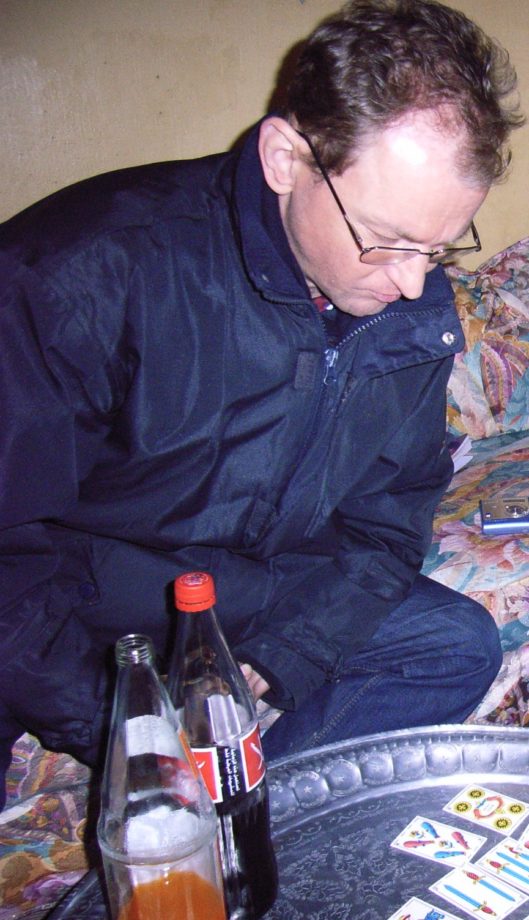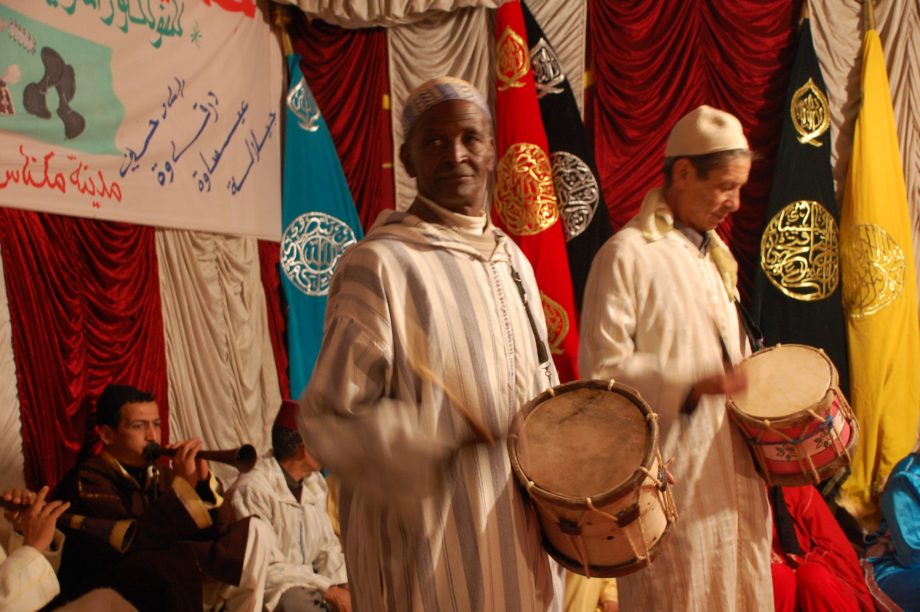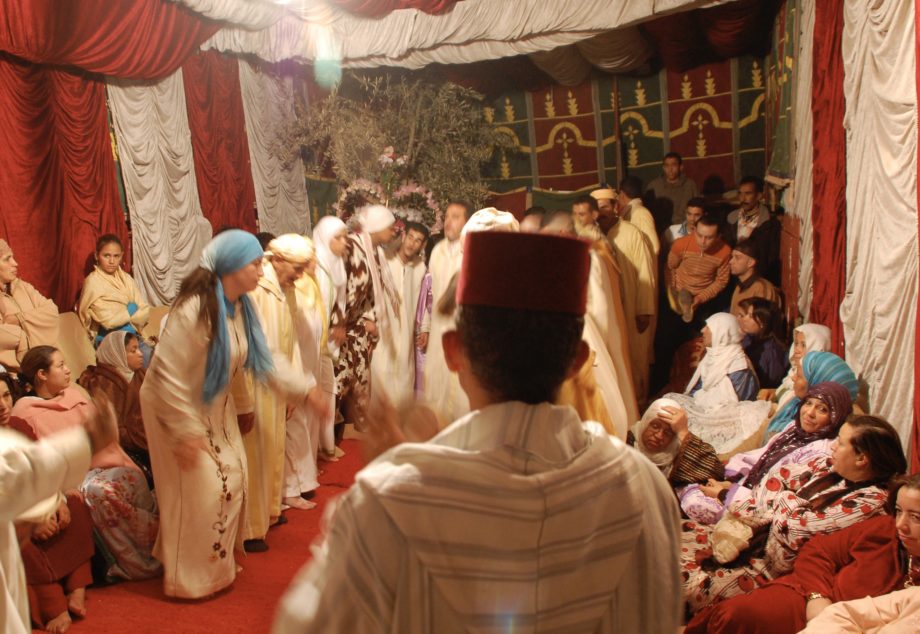Tracing Trance/Mediumism with Erhard in Morocco
Kull uahad u ḥāl dielu. Everybody has his or her own state of trance. When I did my fieldwork in Morocco, I had the privilege to work with the Ḥamādša of the Medina, a confraternity renown for their possession rituals and their relations to the capricious and vengeful demoness (ǧinnīya) ‘Aiša Qandīša. The groups of the Medina were also known for their artful dance movements and their sung poetry. Accepted as a student by the late Ḥamdūši Sidi Allal and befriended with the new, young muqaddim of the ‘Allaliyīn[1], it were the Ḥamādša of the Medina, which performed the bāred[2]for my newborn son Anton. Bringing together the aged adepts of the zāwiya, the meeting place in the old city of Meknes, the performance of a ritual otherwise rarely performed not only honored me and my (absent) family as members of a network of muḥibbūn, it also demonstrated the power of the ritual to create a social body by dancing, singing and keeping together in time. While the only time that I passed out in trance was with this ṭaifa of the Ḥamādša, during a ritual performed for the aunt of the king, I felt ritually at home in the night long rituals of the ‘Isāwa diel ġarb. To me, their ecstatic, communal dances, interrupted by long sequences of communal mourning and ritual sorrow, conveyed this sense of grace that comes with the ritual intimacy of night long gatherings among closely knit networks of muḥibbūn –adepts dedicated to a specific way of worship, kind of dance, and a saintly founding figure. The dissociating effects of trance, however, were most unconcerting for me whenever I accompanied my interlocutors to rituals of the Ǧilala. Their laments and praises sung in high pitched voices that accompany the playing of flute and frame drum (bendīr) had bodily effects on me. Performed to treat individual possession, they regularly grabbed my bones.
Together with Thomas Hauschild, Erhard visited me in the field in 2006. As far as I remember we mostly visited my Ḥamdūši friends then, in particular the zāwiya of the ‘Allaliyīn, the small backyard where we sat next to the shrine of ‘Aiša Qandīša.
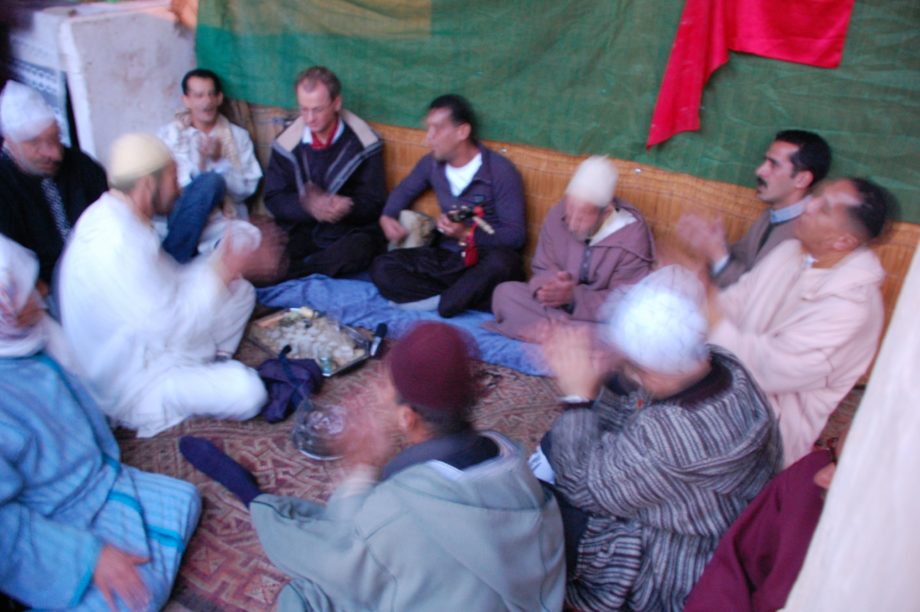
Erhard tracing the rhythm of trance
Generously, they organized a ritual gathering for the esteemed visit. The “small professor”, as Erhard was called – being younger to Thomas by a few years and his former student –, knew how to clap along during the ritual gathering, a delicate endeavor, since a rhythmic mistake amounts to a ritual failure if placed at the wrong time. It was after the ritual gathering that the cards were read to Erhard by an elderly woman, who had adopted me early on in my fieldwork. While she had many gifts, card reading was certainly not among them. Nevertheless it was here that Erhard had a crucial mediumistic moment, receiving decisive news about taking up his professorship in Siegen.
Reading Cards.
During the week we stayed together in my small apartment in Meknes, we started to go through the recordings of the rituals I had received by the members of various trance networks.
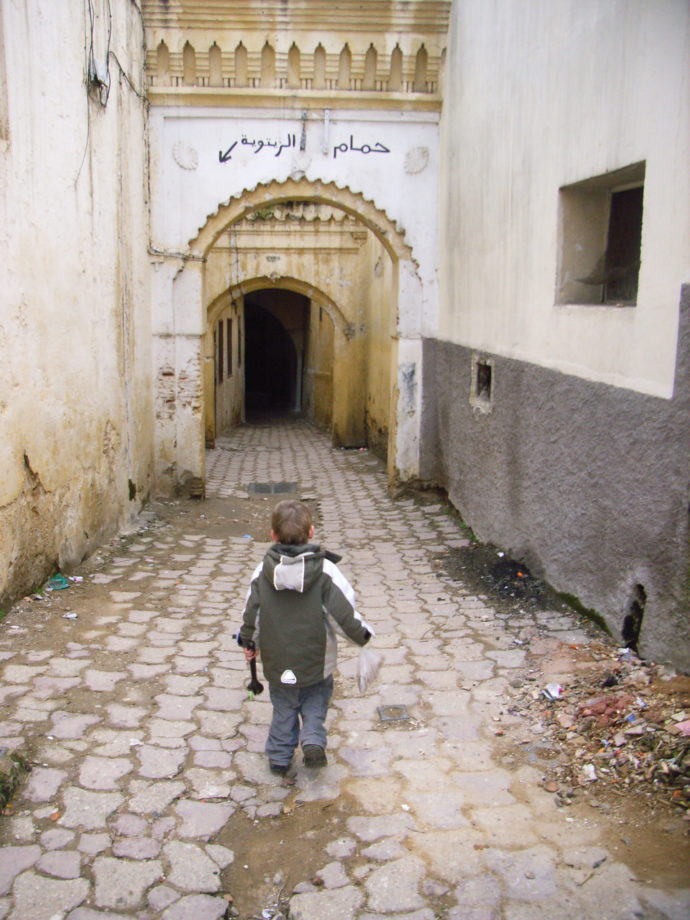
Another visitor carrying breakfast to the apartment in the Medina of Meknes
When I returned to Germany after completing my fieldwork we immediately drafted the first proposal for the research project “Trance Mediums – New Media”, mostly in the kitchen of Marcus Hahn, who kept order (!) of the various ideas, drafts and numbers that came up in our conversation in threes. As part of the successful research application, Anja Dreschke, Erhard and me returned to Morocco to prepare a movie in 2008. We were invited by muqaddim Hamid Buhlal to a līla, a ritual that provided both trance traditions – those of the ‘Isāwa and those of the Ḥamādša diel ġarb. The branch of the Ḥamādša he chose for the ritual also traced its origin to the country side – the ġarb . Like the rural ‘Isawa their rituals were devoid of the verbal art of song poetry (their oboes [Sg. ġīṭa] intonating forgotten songs) and focused on the trance dances. A major difference to the ‘Isāwa is that their rituals are directed solely at individual possession trance. No collective ecstatic choreography, but raw, heavy, trance. If any, it was their ḥāl that grabbed Erhard by the bones, their dark and loud guwāl-drums provided an uncomprising rhythm that carried the dancer into deep trance. Even the “upper” Ḥamdūšis of the city told me that those from the country-side have this specific beauty and sweetness of trance: “When they do the jedba [the wild possession trance], they do it ma’qul [as it has to be]”. (No wonder, Erhard favored them, I think while I am writing this, following, as he does, his own rhythm, in dancing as much as in working.)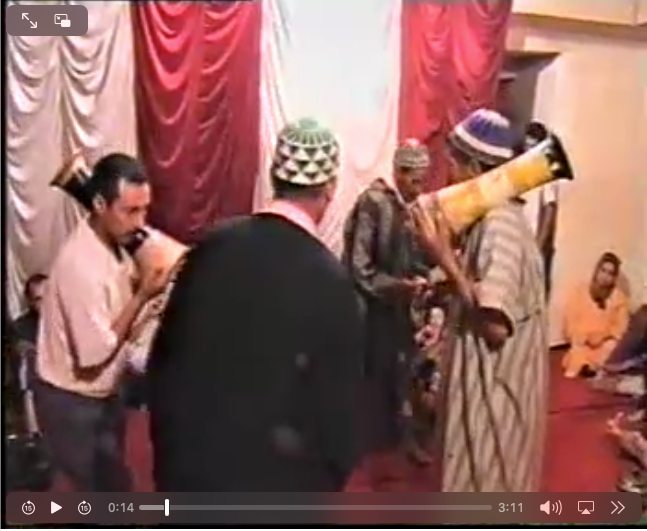
Film-Clip: Finding the tune of trance: the Hamadsha diel gharb (Muqaddim Hamid Buhlal, 2006, access can be provided on request).
Hamid’s ritual was exquisite. He had brought in the best musicians, and the most skillfull trance dancers, shaping the trance spaces of the ǧnūn in most elaborate ways.
Aḥmad A’anūnī playing the tbel, adepts of the ‘Isawa staging trance for the ritual public.
We closely watched how “die Referenz des Rituals” (see Schüttpelz 2012) [3] was established from sequence to sequence of the ritual performance and how its efficacité became manifest in the emotional states of both, those who danced, and those who witnessed their ritual transformations. Carried by the ritual chains of operations, the trance dancers moved away from the ordinary world and what is “given”, [iġībū ʻala al-wuǧūd] working themselves deeper and deeper into trance.
Here and there Erhard has always referred to the Elementary Forms in our conversations, long before I started to read Durkheim in depth when we – Erhard, Ulrich van Loyen, Johannes Schick, Mario Schmidt and myself – took on the “Category project” at the a.r.t.e.s graduate school in Cologne.[4][5] Erhard always reminded his readers and intelocutors of the systematic importance of the “fremde Fremderfahrung” in fieldwork, but anyone who has experienced an ecstatic ritual can only marvel at how detailed Durkheim described this form of progression of ritual sociality, which oscillates between self-perception and self-loss, on the basis of early ethnographies of Australian ‘corrobborees’.
“It is not difficult to imagine that a man in such a state of exaltation should no longer know himself. Feeling possessed and led on by some sort of external power that makes him think and act differently than he normally does, he naturally feels he is no longer himself. It seems to him that he has become a new being. […] And because his companions feel transformed in the same way at the same moment, and express this feeling by their shouts, movements, and bearing, it is as if he was in reality transported into a special world entirely different from the one in which he ordinarily lives, a special world inhabited by exceptionally intense forces that invade and transform him.“ (Durkheim 1995: 220, [transl. Karen Fields])
Over the years we re-visited Hamid’s rituals by watching hours of his ritual recordings in different constellations. Together with Thomas Hauschild and Michael Taussig we tried to trace how these feelings of self loss and mutual estrangement were translated by mutually cooperative bodies into a common ritual experience of patienthood, of excuberant forces that Durkheim and Mauss called effervescence and that are experienced as grace – blessing.
Coming from the study of rhetorics Erhard was prone to detect the “demon or oratorical inspiration” (Durkheim 1995: 212) when we tried to make sense of the “extraordinary surplus of forces“ (ibid.) that literally grasped the attendees, “riding them into trance” as one would put it in Moroccan Arabic. Of course the “Kunst der Menschenführung” is a crucial element in the working of this ritual, as another major author of Erhard’s canonic readings pointed out. For Hocart, ritual authority arises in the necessary coordination of ritual elements and chains of action: „If there is … co-ordination of action, there must be some to command… He who begins by leading ends by directing (Hocart 1970: 37).[6] If successful, ritual efficacité is accomplished and all elements of the ritual chains of operations are reworked, all persons are transformed. This includes the ritual principal of course, who “feels filled to overflowing, as though with a phenomenal oversupply of forces that spill over and tend to spread around him” (Durkheim, ibid.). His ritual agency remains bound to the efficacité of the ritual chains of operation. His functions as (i) agent and (ii) principal are thus coupled to a state of (iii) patienthood, which transforms him into a medium of the forces that seize him, i.e. a healer. This equation is expressed in Hocart’s famous formula: principal = objective = X. The leader and manager of the ritual must delegate ritual agency in order to realise it, i.e. he must act as principal and agent at the same time, mediating between as much as directing the actors – whose patient he becomes, insofar as he must enter a state of dissociation through their activities. Only when the ritual mediation goes full circle can the ritual goal be achieved, and baraka, blessing, becomes manifest.
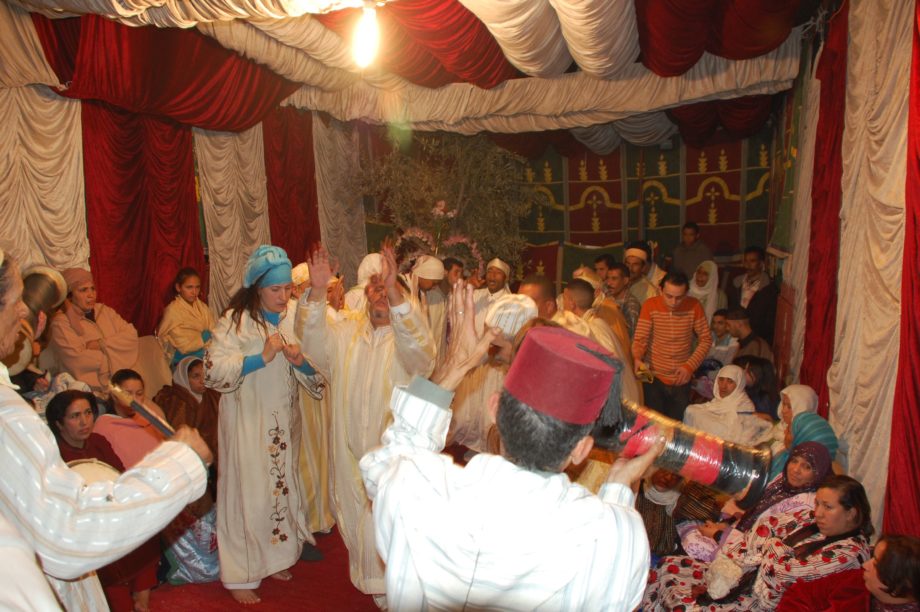
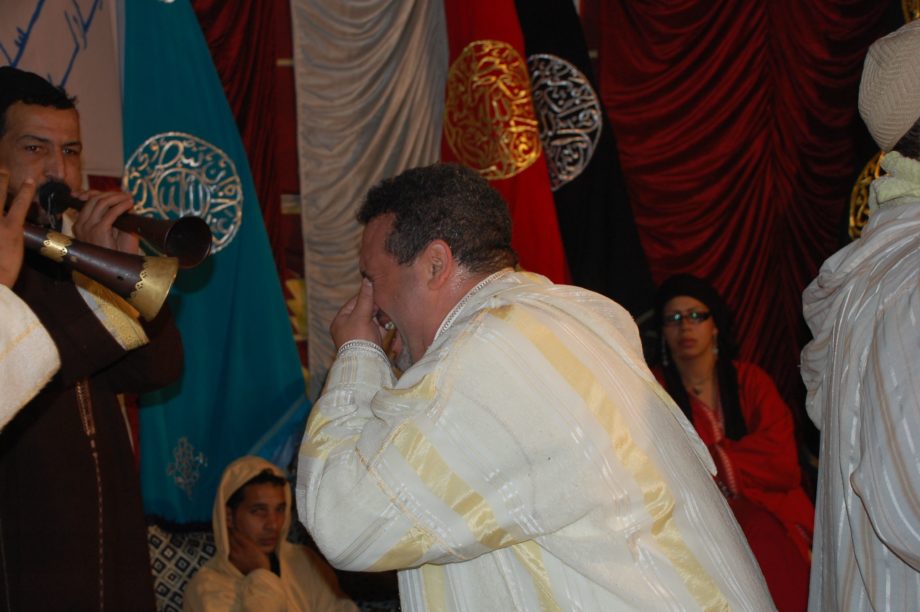
The principal is the objective, is x.
Famously, Durkheim and his students elaborated how religious practice and intercorporeal experiences of the sacred are generic for how socialities are shaped and the world is conceptionalised. But as we learned from N.J. Allen, to Mauss and the second generation of the Durkheim school, pace Durkheim, unitary concepts of the sacred and of the social, as much as unified conceptions of space are not given but result from homogenization, and need to be accounted for. Mauss demanded to think of the sacred as multiple and famously foregrounds the concept of mana in the study of religion. “Heterogeneous and nevertheless immanent” in the world of sensory experience, mana is thought as the other of a unitary category. Associated with practices of magic, not derivative but formative to institutionalized religion, mana provides the milieu, as Mauss had it, that consists of these “ritual gestures, thaumaturgical hopes and objects [of] supernatural powers”, which transgress religious realms and which may form this “sort of lingua franca that is spoken in whispers and still circulates almost silently from one religion to another” as Dionigi Albera suggests and perhaps conjures in his work on religious connectivity along shared and contested sacred spaces (Albera 2012: 244). After our field-trips to Meknes and later Naples, visiting Ulrich van Loyen in his fieldwork on cults of the dead in the underworld of catholic churches, an anthropology of blessing seemed to write forth what Mauss had begun and what we had started by tracing similarities and differences between popular cults and religious movements in the Mediterranean with Thomas Hauschild.[7] Both trained by Thomas Hauschild, who was perhaps the first to teach a whole generation of students Horden’s and Purcell’s History of the Mediterranean[8] (when Peregrine came to Tübingen in 2000, he said he had never seen so many copies of that freshly published book in one room), Erhard translated Mediterranean anthropology into media studies and media studies into Mediterranean anthropology, later employing Lene Faust and Ulrich van Loyen for teaching and researching media theory.
In an e-mail he sent me after we had watched hours of video material with Thomas and Mick from the trance/media archives I collected in Meknes, he condensed another research project for us, subject: Mittel/Meer. In this e-mail Erhard links the art of “Menschenführung” in the (Braudelian) Mediterranean characterized by the scarcity of its most precious research, the people, to the fractured Mediterranean landscapes of scarce ecological ressources. He connects the necessity to engage in redistribution and exchange by the medium of the sea with a “metaphysics of redistribution” (citing the famous fragment of Anaximander) that has as its most crucial element the management of people. Erhard identifies the art of persuasion as a Mediterranean technology that always accompanied the technologies of social persuasion – such as clientelism and gift-exchange – and of course forms of physical violence that erupt periodically in Mediterranean societies as elsewhere. And indeed, if we take trance rituals as technologies of persuasion, it is the oscillation between self-perception and self-loss that needs to be accounted for (with rather than without Durkheim), since “the real basic variable in the „arts of human control“ (Mediterranean or otherwise) consists in the transitions between a refinement of „human control“ and a constant recognition of its uncontrollability, and this uncontrollability (the deepening of its unavailability, which is demographically grounded in its scarcity) lies in the very concrete and existential forms of its unavailability: death, separation, illness, loss of self, obsession, mental defences and social masking. And the religious arts or techniques (ritual techniques) seem to consist in fathoming the transitions between (charismatic) human control and human unavailability and in making these transitions themselves (liminality) an art, by shaping them (we have been looking at it for hours” (Erhard, e-mail Mittel/Meer May 22, 2010, my translation).
After we had spent the night with the trancers, participating in their intense emotional states that are generated, acted out and mutually demonstrated in collective ecstasy, individual absences and mutual care, the discussion of the “Kunst der Menschenführung” – or in antique rhetorics: the art of psychagogy – helped not only to unravel a ritual milieu that triggers and organizes emotions of fear (fright), sadness (crying), joy (laughter), and disgust, it also situated a ritual night in the broader frame of Mediterranean anthropology and ritual life-worlds that still awaits further work.
There are few people in academia that possess Erhard’s gift of intellectual persuasion. Grounded in friendship and affection it has enabled us to venture out into new horizons, and will certainly continue to do so as long as we are willing to take the challenge. Thank you Erhard!
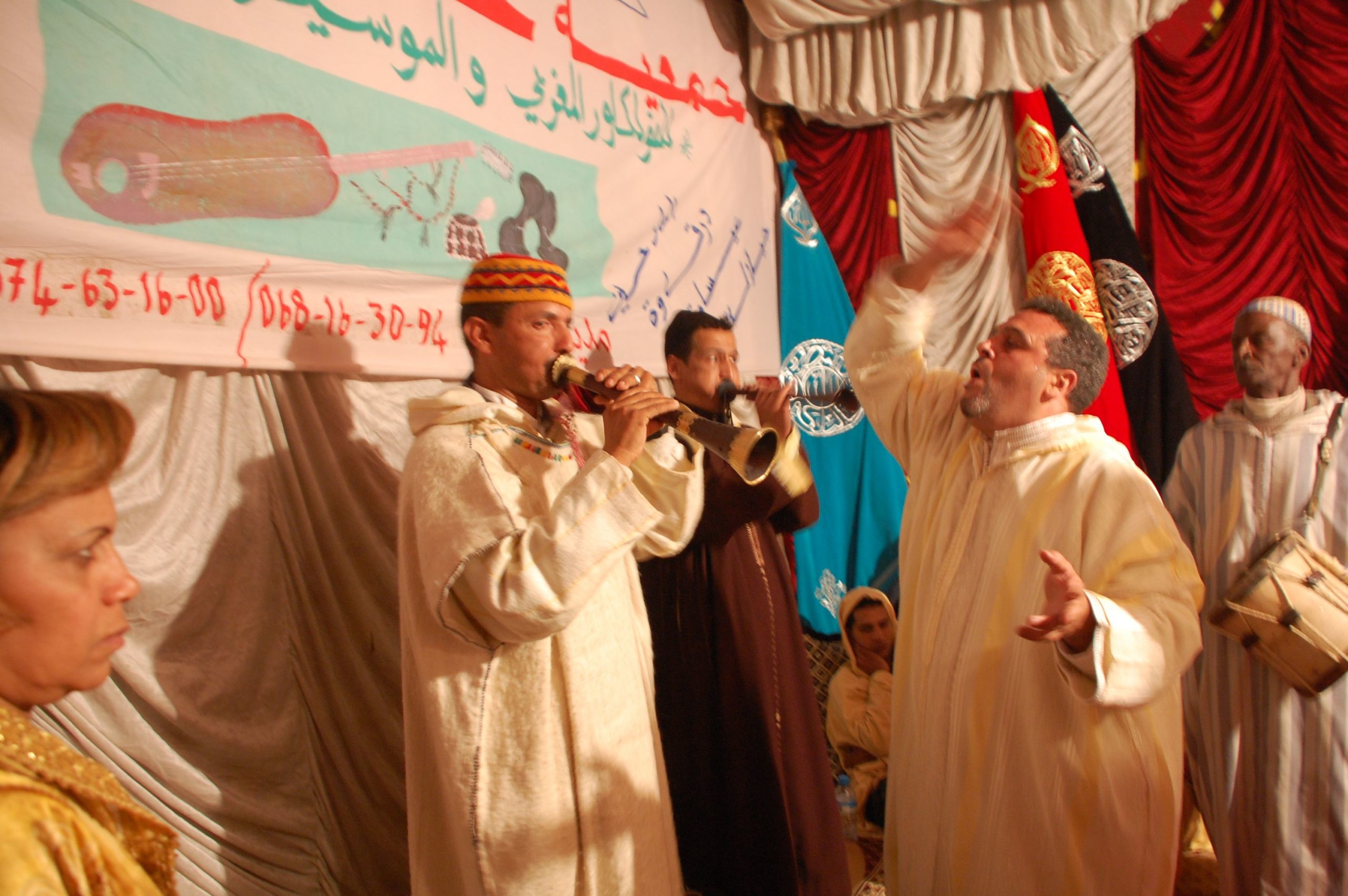
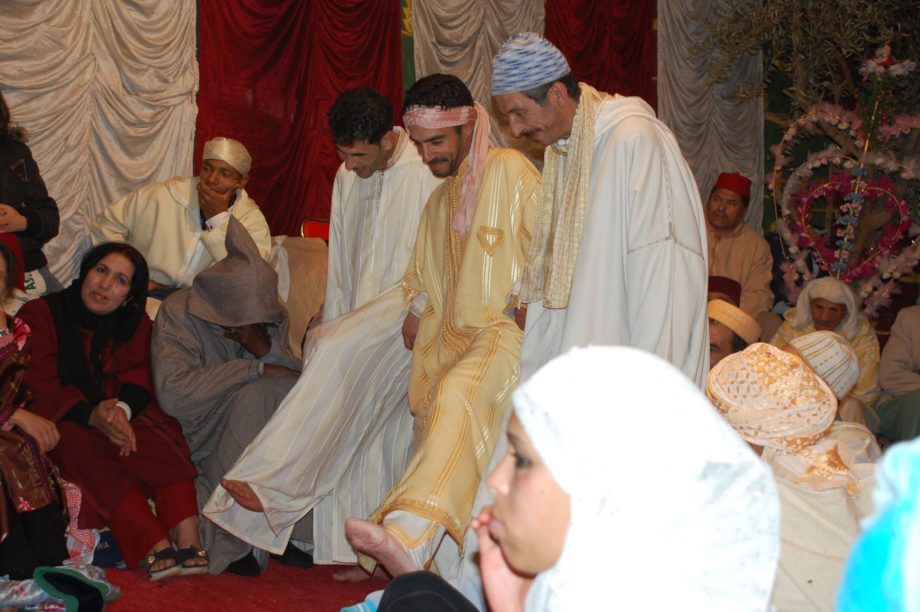
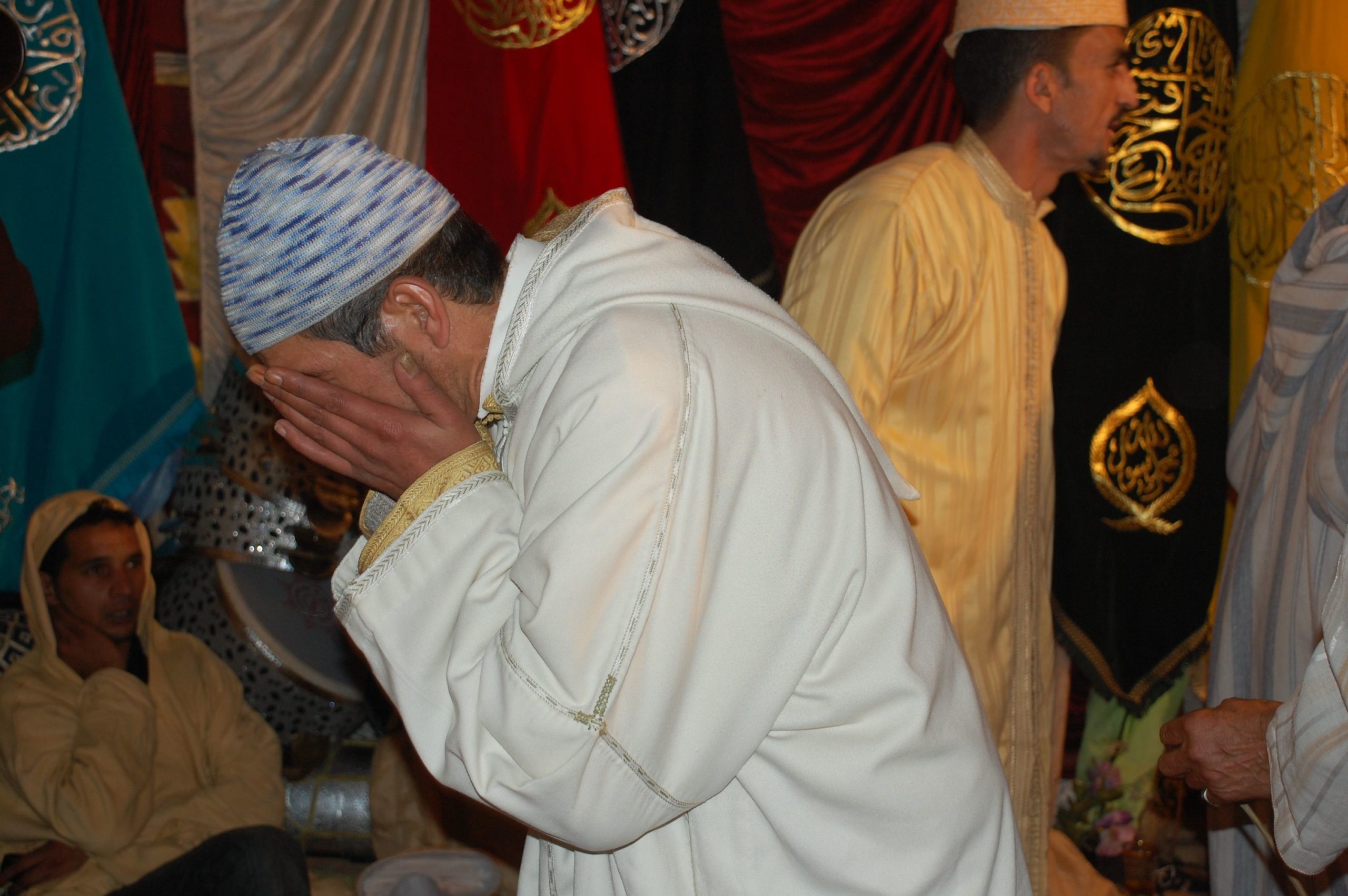
Footnotes
[1] A branch of the Ḥamādša, whose member convene in the sign of the saint Sidi Ali.
[2] The bāred marks a performative climax of a ritual night, for which the men dance towards each other, keeping together in time with the genbrī, a bass guitar, loudly claping the rhythm on the floor with their bare feet, praising God.
[3] Schüttpelz, Erhard (2012): „Die Referenz des Schamanen“, in: Jäger, Ludwig/Fehrmann, Gisela/Adam, Meike (Hg.): Medienbewegungen. Praktiken der Bezugnahme. Paderborn: Wilhelm Fink, S. 243-259.
[4] (Mauss-) Werkstatt: Unbekannte Monde am Firmament der Vernunft. With a translation of Marcel Mauss‘ „Conception qui ont précédé la notion de la matière“, in: Erhard Schüttpelz und Martin Zillinger (eds.): Begeisterung und Blas-phemie. Zeitschrift für Kulturwissenschaften 2/2015
[5] Johannes Schick, Mario Schmidt, Zillinger, Martin (eds.) 2022: On the Social Origins of Thought. The Category Project of the Durkheim School, Oxford: Berghahn, in press
[6] Hocart, Arthur M. (1970): Kings and Councillors: An Essay in the Comparative Anatomy of Human Society, Chicago, IL.
[7] Hauschild, Thomas, Kottmann, Sina, Zillinger, Martin 2007: Syncretism in the Mediter-ranean: Universalism, Cultural Relativism and the Issue of the Mediter-ranean as a Culture Area, in: History and Anthropology 18, S. 309-332
[8] Horden, Peregrine, and Nicholas Purcell 2000: The corrupting sea. A study of Mediterranean history. Oxford: Wiley-Blackwell.
































